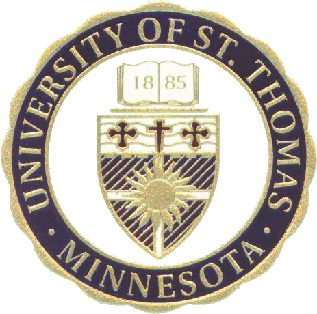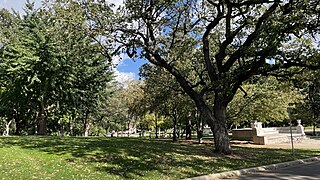
Metropolitan State University is a public university in the Minneapolis–St. Paul,Minnesota metropolitan area. It is a member of the Minnesota State Colleges and Universities system.

St. Olaf College is a private liberal arts college in Northfield,Minnesota. It was founded in 1874 by a group of Norwegian-American pastors and farmers led by Pastor Bernt Julius Muus. The college is named after the King and the Patron Saint Olaf II of Norway and is affiliated with the Evangelical Lutheran Church in America.

The University of Minnesota Twin Cities is a public land-grant research university in the Twin Cities of Minneapolis and Saint Paul,Minnesota,United States. The Twin Cities campus comprises locations in Minneapolis and Falcon Heights,a suburb of St. Paul,approximately 3 mi (4.8 km) apart.

Dunwoody College of Technology is a private technology school in Minneapolis,Minnesota. It offers Bachelor of Science (B.S.),Bachelor of Architecture and Associate of Applied Science (A.A.S.) degrees.

The University of Minnesota Duluth (UMD) is a public university in Duluth,Minnesota,United States. It is part of the University of Minnesota system. UMD offers 17 bachelor's degrees in 87 majors,graduate programs in 24 different fields,a two-year program at the School of Medicine,and a four-year College of Pharmacy program.

The University of St. Thomas is a private Catholic research university with campuses in St. Paul and Minneapolis,Minnesota. Founded in 1885 as a Catholic seminary,it is named after Thomas Aquinas,the medieval Catholic theologian and philosopher who is the patron saint of students. As of fall 2021,St. Thomas enrolled 9,347 students,making it Minnesota's largest private,nonprofit university.

Maria Louise Sanford was an American educator. She was a professor of history at Swarthmore College from 1871 to 1880 and a professor of rhetoric and elocution at the University of Minnesota from 1880 to 1909.

Hamline University is a private university in Saint Paul,Minnesota,United States. Founded in 1854,Hamline is the oldest university in Minnesota,the first coeducational university in the state,and is one of five Associated Colleges of the Twin Cities. The university is named after Bishop Leonidas Lent Hamline of the United Methodist Church. As of 2017,Hamline had 2,117 undergraduate students and 1,668 graduate students.

Fitchburg State University is a public university in Fitchburg,Massachusetts. It has 3,421 undergraduate and 1,238 graduate/continuing education students,for a total student body enrollment of 4,659. The university offers undergraduate and graduate degrees in 25 academic disciplines. The main campus,the McKay Campus School,and athletic fields occupy 79 acres (320,000 m2) in the city of Fitchburg;the biological study fields occupy 120 acres (490,000 m2) in the neighboring towns of Lancaster,Leominster,and Lunenburg.

Marion LeRoy Burton was the second president of Smith College,serving from 1910 to 1917. He left Smith to become president of the University of Minnesota from 1917 to 1920. In 1920,he became president of the University of Michigan,where he served until his premature death,aged 50,in 1925 from angina.

Franklin College is a private liberal arts college in Franklin,Indiana. It was founded in 1834 and has a wooded campus spanning 207 acres (84 ha) including athletic fields and a 31-acre (13 ha) biology woodland. The college offers its approximately 1,000 students Bachelor of Arts degrees in 49 majors from 25 academic disciplines,43 minors,11 pre-professional programs,and 5 cooperative programs. The college also offers a Master of Science in Athletic Training and a Master of Science in Physician Assistant Studies. In 1842,the college began admitting women,becoming the first coeducational institution in Indiana and the seventh in the nation. Franklin College has historically maintained an affiliation with the American Baptist Churches USA.

Salem State University is a public university in Salem,Massachusetts. Established in 1854,it is the oldest and largest institute of higher education on the North Shore and is part of the state university system in Massachusetts.

Coffman Memorial Union is a student union on the East Bank campus of the University of Minnesota in Minneapolis. Situated near the Mississippi River,Coffman anchors the south end of Northrop Mall,a grassy area at the center of campus that is bordered by the University's physics,mathematics,chemistry,and administration buildings,plus Walter Library and Northrop Auditorium. Coffman sits at the south end of the mall,across Washington Avenue,and opposite Northrop.

“The Minnesota March” is a march for wind band written by John Philip Sousa in 1927 for the University of Minnesota. Sousa received an informal request for the march from Minnesota football coach Clarence Spears,and agreed to a request from a committee of university officials in October 1926. Sousa used Indian themes in this march,and later added field drum and bugle parts. The march was published by the Sam Fox Publishing Company and was premiered by Sousa and his band on September 3,1927 at the Minnesota State Fair. It was first performed at the University of Minnesota the next month,on October 26,with a performance by the university band.

The University of Minnesota Old Campus Historic District is a historic district located in Minneapolis,Minnesota. Listed in the National Register of Historic Places since 1984,it includes a number of historic buildings that were constructed during the late 1800s and early 1900s,and represents the oldest extant section of the University of Minnesota campus. The general area was designed by landscape architect Horace W. S. Cleveland,who envisioned a park-like University. His plan,that he presented to the Board of Regents,went on to help form the Historic District. It is located directly to the north of the University's Northrop Mall Historic District.

The University of Minnesota School of Dentistry is the dental school of the University of Minnesota. It is located in Minneapolis,Minnesota,United States.

Louise M. Powell (1871–1943) was an American nurse and educator who led the University of Minnesota School of Nursing,during its formative years. During her tenure there (1910–1924),the university established a five-year baccalaureate nursing degree program. In honor of her achievements,the nurses residence hall was named for her in 1939. She was later dean of nursing at Western Reserve University.

Agnes Moore Fryberger was an American music educator,lecturer,and author,as well as a clubwoman. She was a pioneer in the northwestern U.S. in lecture recitals on opera. Fryberger served as the Educational Director of the Minneapolis Symphony Orchestra (1924-25),and of the St. Louis Symphony Orchestra (1926-30). She was the first director of music appreciation at the University of Louisville. Her book,Listening Lessons in Music (1916),used in France,England,and the Philippines,was the first text that incorporated phonograph records into a school lesson's grading process.
In Minnesota,developmentally disabled people,most of whom were women,were involuntarily committed to state guardianship and sterilized,but today,many of those who were either committed to state guardianship or sterilized would not be considered disabled. Eugenic ideals were popular in the state during much of the early-mid 1900s.

















